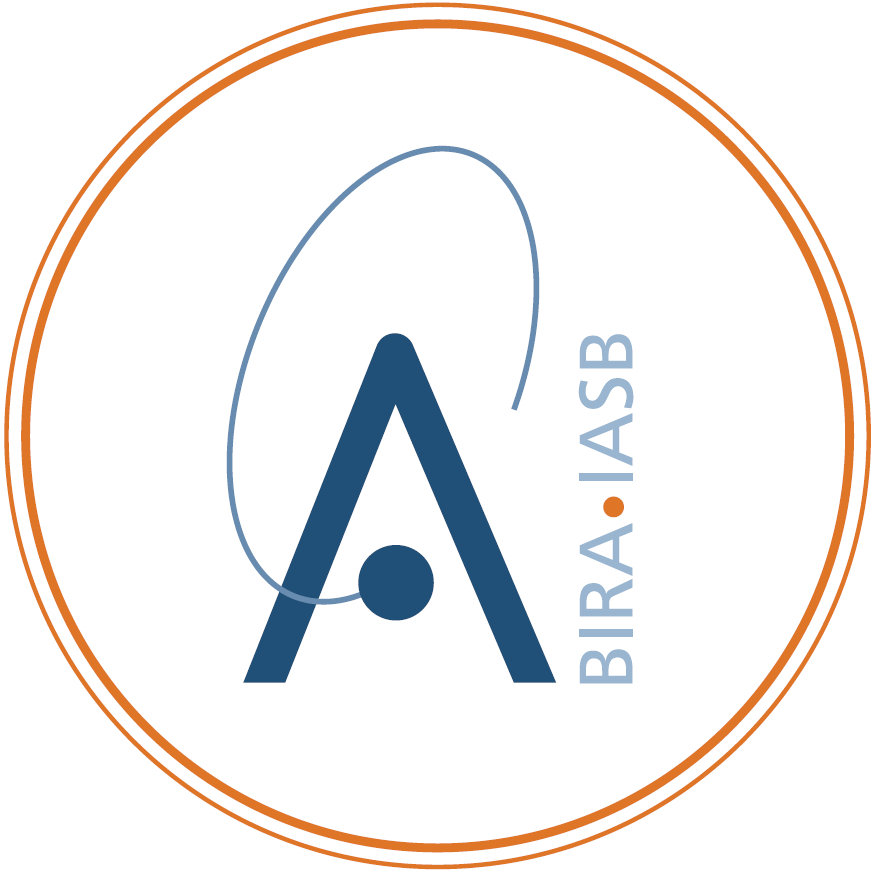
European Space Agency¶

Royal Belgian Institute for Aeronomy¶

ut550 - select a coordinate transformation¶
- subroutine ut550(kfrom, kto, trans, ifail)¶
- Parameters:
kfrom [integer4,in] :: input coordinate system
kto [integer4,in] :: output coordinate system
trans (3,3) [real8,out] :: transformation matrix
ifail [integer4,out] :: error flag (see Diagnostics)
Description¶
The subroutine
ut550()initializes the coordinate transformation. The computed transformation can be applied then with the help of subroutineut555()orut556(). The argumentskfromandktoare used to specify the input and output coordinate systems, respectively. The resulting matrixtransallows to transform cartesian coordinate of typekfromto typekto.The correspondance between indices and coordinate systems is shown in the table below
kfrom, kto |
coordinate system |
|---|---|
1 |
Geographic coordinate (GEO) |
2 |
Geocentric equatorial inertial coordinate (GEI) |
3 |
Geomagnetic coordinate (MAG) |
4 |
Solar magnetic coordinate (SM) |
5 |
Geocentric solar magnetospheric coordinate (GSM) |
6 |
Geocentric solar ecliptic coordinate (GSE) |
The characteristics of the five coordinate systems are summarized in the next table. The origin of all these coordinate systems are located at the centre of the Earth.
Coordinate Systems¶
X axis |
Y axis |
Z axis |
|
|---|---|---|---|
GEO |
included in the Earth’s equatorial plane and passing through the Greenwich meridian |
\(\vec{Z} \times \vec{X}\) |
parallel to the Earth’s rotation axis and pointing to the North |
GEI |
pointing to the first point of Aries, i.e. at the intersection between the Earth’s equatorial plane and the ecliptic plane |
\(\vec{Z} \times \vec{X}\) |
parallel to the Earth’s rotation axis and pointing to the North |
MAG |
\(\vec{Y} \times \vec{Z}\) |
perpendicular to both the geomagnetic dipole axis and the Earth’s rotation axis in the East direction |
parallel to the geomagnetic dipole axis and pointing to the North |
SM |
\(\vec{Y} \times \vec{Z}\) |
perpendicular to the Earth-Sun line towards dusk |
parallel to the geomagnetic dipole axis and pointing to the North |
GSM |
pointing towards the Sun |
perpendicular to the geomagnetic dipole axis such that the Z axis is pointing to the North |
\(\vec{X} \times \vec{Y}\) |
GSE |
pointing towards the Sun |
\(\vec{Z} \times \vec{X}\) |
perpendicular to the ecliptic plane and pointing to the North |
Note
The coordinate transformation generally depends on the Sun position and/or the geomagnetic dipole field. For this information, the subroutine ut550() makes use of the data stored in the argument mint and msun of the common block uc140. The common block uc140 can be initialized by the subroutines um510() and um520(). The Sun position can be modified without affecting the external magnetic field model by a call to subroutine um522().
References¶
Olson, W.P., Coordinate Transformations Used in Magnetospheric Physics, McDonnell-Douglas Astronautics Company Paper WD1145 (1970).
Russell, C.T.,Geophysical Coordinate Transformations, Cosmic Electrodynamics 2 (1971) 184-196.
History¶
The subroutine
ut550()does not exist in version 1.05 and earlier. The transformation from/to the GSE coordinate system is not included in version 2.00 and earlier.The subroutine
ut550()includes an error in versions 2.01 to 2.03 that affects transformation from/to the GSE coordinate system. Due to this error the GSE coordinate axes are reverted in some conditions. The error is corrected in version 2.05.Additional sporadic errors have been fixed in version 2.09.
Diagnostics¶
-55001, invalid coordinate system
-55002, -55003, -55004, problem with the Sun direction
Common Blocks¶
Dependencies¶
Called by¶
None
Calls¶
None
See also¶
Reported Bugs¶
v1.07, Erroneous behaviour of the coordinate transformations relative to GSM and MAG coordinate systems, fixed in next versions (this erroneous behaviour does not affect the subroutine
um523()).
Examples¶
None
UNILIB/tags/v3.02
